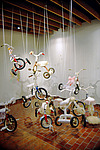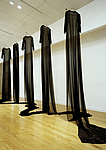Mary Tuma: Dancing Girls, Passages and Homes for the Disembodied
Maymanah Farhat
Dar Al Hayat_Eng - 17/10/05
Since 1992, Palestinian-American artist Mary Tuma has been creating works that address issues of the body, the spirit and identity. Tuma's work incorporates the use of textiles, found objects and costume design in installation works that are profoundly introspective; yet engage the viewer through explorations of the human condition. Tuma's experimentation with installation art began while receiving her MFA from the University of Arizona at Tucson . She currently teaches art at the University of North Carolina at Charlotte and has been exhibiting her work since 1993.
Tuma's work conveys physical and spiritual transformations and is accompanied by insights on mortality, traumatic life changes, and humanity. Through such installation works as Dancing Girls, 1999, Passages, 2000, and Homes for the Disembodied, Tuma articulates personal and communal journeys of such issues.
Dancing Girls by Mary Tuma.
In Dancing Girls Tuma examines changes in the body and how the spirit transcends such experiences. The installation work consists of a series of found tricycles hung with white string from the ceiling in a manner that simulates an ascent into another spiritual realm. The tricycles are hung so that their shadows reflect along the walls and floor of the gallery space, evoking a sense of movement. In an artist's statement that includes a discussion of the work, Tuma affirmed, "Dancing Girls is about the transformation that the body goes through with death and change. It is about a sort of out-of-body experience, a shaman's travel into other worlds, and travel via our imaginations."
The tricycles are covered by various materials such as fabric, fur and lace, which give the transcendent journey an animated childlike appearance. The inspiration for Dancing Girls came from Tuma's own personal belief system and the role of Pre-Columbian Peruvian textiles in shaman practices. Each tricycle appears as a new formation of the body while the shadows seem spirit-like in nature, reflecting physical courses of change. Tuma captivates the viewer with spirits that travel towards transcendence through a cyclone of bodies in transformation.
Passages.
With Passages, Tuma creates a physical space of mourning that induces the intense tragedy of those who have died from the violence that plagues the Palestinian/Israeli conflict. Passages was made in November 2000 after the beginning of the Al Aqsa Intifada in Israel , the West Bank and Gaza . During the second uprising, Tuma was inspired by news coverage she received from Internet reports by those experiencing the conflict firsthand. The installation work was first developed and shown in a space of five hundred square feet at the Queens College Art Gallery in Charlotte , North Carolina . Every inch of the five hundred square foot space was transformed to create what appears to be a gathering of departed souls, what Tuma describes as, "both a memorial to those who lost their lives in this terrible conflict and a plea for a fair and just resolution that recognizes international law and human rights."
The walls of the space are covered by commercial clothing patterns. With the outlines of the patterns, Tuma suggests the flattening of bodies that remain faceless. These figures are unidentified yet they cannot be ignored. By covering the walls of the space with such patterns, Tuma implies, "the depersonalizing of the 'other'." Just as the figures of the clothing patterns are two-dimensional, Tuma affirms that the objectification of "the other" attempts to strip a people or culture of its humanity. Tuma's subjects are no longer tangible beings through such representation. The figures are reduced to sterile outlines that await the manipulation of their forms by a seamstress, or in this case the objectifier. By using such representations, Tuma portrays the dehumanization of the Palestinian people in media coverage of the Palestinian/Israeli conflict.
She counters such objectification with excerpts of personal accounts of the conflict that are written in charcoal and graphite. The passages that record funeral processions, shootings and attacks are written on the walls. One reoccurring quote reads, " …shot and killed today by live ammunition to his head." The power of such writings juxtaposed with Tuma's representation of objectification impacts the viewer with severity. Tuma simultaneously calls attention to the misconceptions of the political conflict while shedding light on the catastrophic reality of life and death under occupation and turmoil.
Wooden cradles that lie within the center of the installation space further articulate the reality of the conflict. The cradles are made from branches and hang from the ceiling. Attached to each vessel are small packages, which represent remains of personal stories and the aspects of life that are left unresolved when one's life is interrupted so abruptly. The cradles symbolize passages to the afterlife yet appear anchored mid-journey by the fragments of unfinished personal stories that weigh heavily on the spirit. Beneath the cradles are solemn reds that are painted upon the entire floor of the installation space. The various hues of red insinuate bloodshed and add to the powerful impact of Tuma's memorial space. Through Passages, the viewer is presented the tragic reality of a people whose existence and fate is determined by the day-to-day outcomes of a violent political conflict.
Homes for disembodied.
The difficult living conditions of the Israeli occupation of Palestine are also conveyed in Tuma's installation piece, Homes for the Disembodied. In Homes for the Disembodied Tuma folded fifty yards of black chiffon to create five connected dresses, which can stand as tall as fifteen feet high while covering a floor space of twenty-four feet. The dresses are hung from wire forms at the neck and shoulders and are placed in a line. Homes for the Disembodied exhibited in the Made in Palestine exhibition, which has received critical acclaim since it's opening in 2003 at the Station Museum in Houston , Texas and continues to tour galleries and museums.
Tuma's creation of five dresses from one large piece of chiffon is momentous and communicates the collective adversity faced by the Palestinian people. The installation work's presence is stoic yet the minimal physical support of the black chiffon creates figures whose forms are vulnerable to the space in which they are displayed. Such conflicting physical elements of the piece suggest the difficulties faced by Palestinian women living under Israeli occupation. They must remain strong, despite the most harrowing conditions. Tuma describes the heroic scale of the dresses as reflecting, "the strength and courage of Palestinian women who must carry on in unjust circumstances they have little power to change."
While the monumental size and presence of the piece fascinates the viewer, the delicate nature of the chiffon speaks of the fragile state of lives that are at risk of being uprooted or taken at any given time due to political turmoil. For Tuma, Homes for the Disembodied functions as, "…both a memorial to and an offering for the people displaced from Jerusalem who were unable to return to their homes before their death…It is very much a spirit dwelling place-a comfort zone for spirits without a home."
Details of clothing patterns.
In Dancing Girls, Passages and Homes for the Disembodied, Tuma enthralls the viewer with journeys of the human form throughout emotional and corporal experiences. Tuma does so by presenting some of the most difficult conditions in which humanity is struggling to survive. Through her work we are reminded of the delicate nature of life, and are provided a greater understanding of the human condition. For more information please contact



